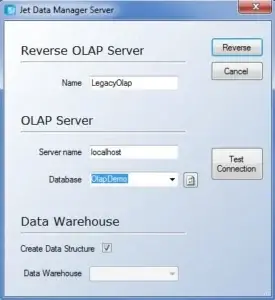What is Reverse OLAP Engineering?
If your organization already has OLAP cubes built in SQL Server Analysis Services (2005 or later), there’s good news — you don’t have to rebuild everything from scratch in Jet Analytics. With the Reverse Engineer OLAP feature in the Jet Data Manager (JDM), you can import those existing cubes into your JDM project and start managing them there moving forward.
⚠️ Note: This feature is not included in the standard Jet Analytics license. It’s an add-on that can be purchased separately.
Why Use This Feature?
Save time by reusing existing OLAP cubes.
Transition smoothly to Jet Data Manager without losing past work.
Quickly generate matching data structures in the JDM environment.
How to Reverse Engineer an OLAP Database
Here’s how you can bring your existing OLAP database into Jet Data Manager:
Go to the Cubes tab in JDM.
Right-click the OLAP Server node.
Select “Reverse OLAP Server 2005 and above”.
This will open a dialog box where you’ll enter some key information:
Name – The name you want to assign to this OLAP node in JDM.
Server Name – The server where the OLAP database currently exists.
Database – Choose the OLAP database you want to import.
✅ Create Data Structure (checked by default):
This tells JDM to scan the source OLAP cube and automatically create the necessary data warehouse tables and fields.
If you uncheck this box, you’ll need to manually point to an existing data warehouse that will serve as the data source.
Things to Keep in Mind
Jet Data Manager can recreate the structure of the OLAP cubes — including measures, dimensions, hierarchies, and relationships.
However, it can’t see the transformations or logic used to prepare the original data. You’ll still need to connect your data source and apply any necessary transformations yourself.
If your original cube had computed columns, JDM will ask if you want to convert them into derived measures. You can choose either option based on your needs.
During the process, you’ll also be asked if Jet Data Manager should remove system-specific naming conventions. The default option is Yes, which keeps your project clean and easy to understand.
What Gets Imported?
Once complete, your JDM project will include:
Cube names
Standard, derived, and calculated measures (including formulas and formatting)
Dimensions, levels, and hierarchies
Dimension keys and relationships
You’ll also see all the required tables and fields in the Data tab — ready for you to map your original data source.
👉 Join our Jet Analytics Training and master building data warehouses, cubes, and advanced dashboards.
Next Steps
After the reverse engineering is done, your focus should be on:
Connecting the right data sources
Mapping them to the new data warehouse structure
Applying any data transformation rules needed
The Reverse Engineer OLAP feature in Jet Data Manager is a huge time-saver for teams transitioning to Jet Analytics. You get to keep the structure of your existing OLAP cubes and build upon them using the full power of JDM — without starting from scratch.








